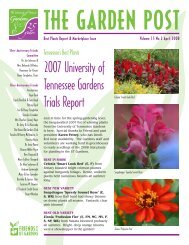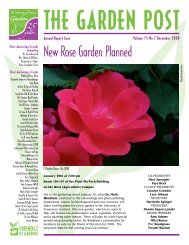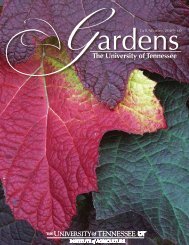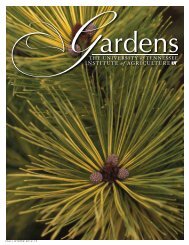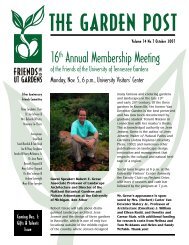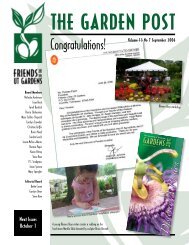May - UT Gardens - The University of Tennessee
May - UT Gardens - The University of Tennessee
May - UT Gardens - The University of Tennessee
Create successful ePaper yourself
Turn your PDF publications into a flip-book with our unique Google optimized e-Paper software.
Thomas Jefferson’sKitchen Garden2007 <strong>UT</strong> Heirloom Vegetable GardenThis is the fifth year to cultivate the soil in our vegetableplot at the <strong>UT</strong> <strong>Gardens</strong> and I am pleasedto announce that we have chosen “ThomasJefferson’s Kitchen Garden” for our theme <strong>of</strong> theheirloom vegetable garden. <strong>The</strong> terraced garden atMonticello, near Charlottesville, Va., is probably themost famous kitchen garden in the country, and Ilearned so much about the garden while I studiedat Monticello last summer. This experience ledme to a greater level <strong>of</strong> appreciation for heirloomgardening. Jefferson was a passionate and dedicatedgardener and collected amazing numbers <strong>of</strong>vegetable varieties in his life time. Our heirloomexpert, John Coykendall, and I will demonstrate acolonial kitchen garden, just like Jefferson’s, on asmaller scale at the <strong>UT</strong> <strong>Gardens</strong> this summer.<strong>The</strong> seedlings <strong>of</strong> spring vegetables are getting readyto be put out in the <strong>Gardens</strong> any time now. Johnand I carefully selected vegetables that Jeffersonparticularly liked to grow and eat, as well as somepopular varieties that were commonly grown in the19 th century kitchen gardens.In early spring, we will start with some <strong>of</strong>Jefferson’s favorite lettuce varieties, ‘Tennis Ball,’‘Bath Cos’ and ‘Brown Dutch’ lettuce, as well ashis prized peas, ‘Prince Albert’ and ‘Blue Prussian.’Jefferson was also known as one <strong>of</strong> the first peopleto grow tomatoes for eating. Before that time,people were afraid <strong>of</strong> eating tomatoes for they werethought poisonous, as are many other members<strong>of</strong> the nightshade family. You will find ‘Large Red’tomatoes in our garden this summer as one <strong>of</strong> therare tomato varieties from the 19 th century, becausetomatoes that Jefferson used to grow have unfortunatelydisappeared over the years. Other summercrops include white eggplant, red orach, Florencefennel, sesame, large red cayenne pepper, pricklyseededspinach, and more. We will also attemptto continue with our garden through fall and earlywinter with some late season crops, such as ‘ChinaRose’ winter radish, ‘Early Curled Siberian’ kale,walking onion and globe artichoke.<strong>The</strong>re will be interpretive signs for each vegetable atthe <strong>Gardens</strong>, and John will be speaking about thisheirloom collection at the Blooms Days in June. Ifyou would like more information or want to help memaintain this garden, please contact me at tsaito@utk.edu or 974-7256.—Terumi Watson, graduate studentNews BriefsCaula A. BeylIn late March, Joseph DiPietro, vice president foragriculture, announced the appointment <strong>of</strong> a newdean for the College <strong>of</strong> Agricultural Sciences andNatural Sciences. After a rigorous search process,Caula A. Beyl was selected from a pool <strong>of</strong> manyqualified candidates. She currently serves as director<strong>of</strong> the Office <strong>of</strong> Institutional Planning, Research andEvaluation for Alabama A&M <strong>University</strong>. A pr<strong>of</strong>essor<strong>of</strong> horticulture, she has received numerous awardsand recognitions for teaching and research. She hasalso served in editorial and review capacities fora number <strong>of</strong> scholarly publications, including theJournal <strong>of</strong> the American Society for HorticulturalScience. Dr. Beyl holds a Ph.D. in stress physiologyand a master’s in horticulture from Purdue <strong>University</strong>.12



